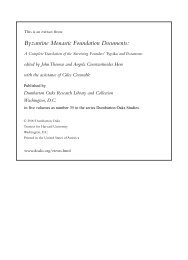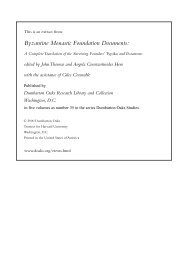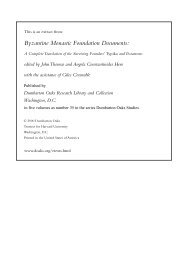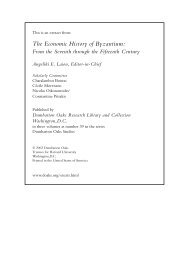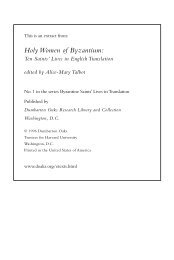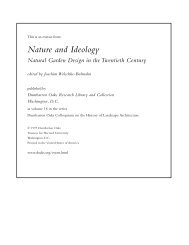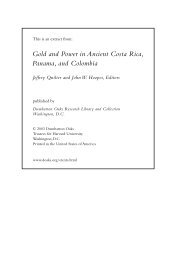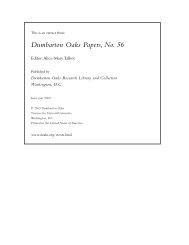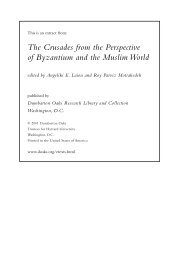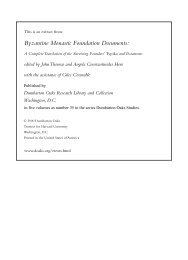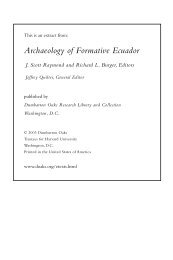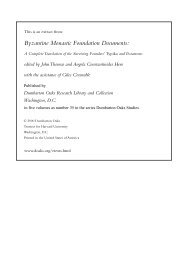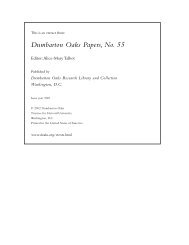22. Evergetis - Dumbarton Oaks
22. Evergetis - Dumbarton Oaks
22. Evergetis - Dumbarton Oaks
Create successful ePaper yourself
Turn your PDF publications into a flip-book with our unique Google optimized e-Paper software.
ELEVENTH CENTURY<br />
29. See my “Documentary Evidence” and “<strong>Evergetis</strong> Monastery.”<br />
30. For limits on numbers elsewhere in earlier and contemporary documents, see (9) Galesios [246], (10)<br />
Eleousa [5], (13) Ath. Typikon, (16) Mount Tmolos [1], [2], (17) Nikon Metanoeite [5], and (19) Attaleiates<br />
[27].<br />
31. Pseudo-Basil, Poenae 13, 59, PG 31, cols. 1308C, 1313C.<br />
32. See below, Chapters Five and Six.<br />
33. See (9) Galesios [223] and (15) Constantine IX.<br />
34. Not surprisingly, this radical idea is not picked up by any of the successor institutions in the Evergetian<br />
tradition except for (30) Phoberos [35].<br />
35. For examples, see (35) Skoteine [33], [38], [39].<br />
36. See (4) Theodore Studites [9], [15], [16], [17].<br />
37. Note, for example, the placement of the heading to [4], which consigns the author’s introduction to the<br />
discussion of the hours to [3], a discussion of his role in the development of the foundation; the heading<br />
to [18], which isolates the author’s own introduction to [18] with [17]; the heading to [35], which<br />
likewise isolates the author’s own transition to the subject of discussion in [35] in [34]; the especially<br />
awkward placement of the heading for [39], which divides the author’s discussion of the exclusion of<br />
women into two chapters; and the heading to [39], which fails to describe both of the two very different<br />
topics included in this chapter.<br />
38. E.g., (32) Mamas [47] and (33) Heliou Bomon [46], which both appear to “remedy” the awkward division<br />
between (22) <strong>Evergetis</strong> [3] and [4]; (27) Kecharitomene [13], which “ignores” the division between<br />
(22) <strong>Evergetis</strong> [13] and [14]; (30) Phoberos [36], which does the same for the divisions among<br />
(22) <strong>Evergetis</strong> [15], [16], and [17]; (30) Phoberos [48], which appears to “consolidate” (22) <strong>Evergetis</strong><br />
[31], [32], and [33], or (30) Phoberos [55], which “remedies” the awkward division between (22)<br />
<strong>Evergetis</strong> [38] and [39]. There are many other possible illustrations of this editorial phenomenon.<br />
39. Note repetitive treatments of: [7] confession to the superior, cf. [15]; [9] no secret eating, cf. [22]; [9]<br />
duties of the refectorian and disciplinary official, cf. [31]; [9] condemnation of quarrels over precedence,<br />
cf. [42]; [13] investiture ceremony for officials, cf. [29]; [20] duties of the treasurer, cf. [30];<br />
[22] no personal possessions, cf. [27], [42]; and [32] warning against careless administration of the<br />
monastery’s property, cf. [42].<br />
40. (22) <strong>Evergetis</strong> [14], [18], [19], [20], [32], [42].<br />
41. Alexios Komnenos, Novella de sacris vasibus in publicum usum non convertendis (1082) (JGR 3.355–<br />
58) = Dölger, Regesten, no. 1085.<br />
42. See John of Antioch, De monasteriis, chap. 18, ed. P. Gautier, REB 33 (1975), 129, cf. 80–86, with V.<br />
Grumel, La Chronologie (Paris, 1958), p. 480.<br />
43. Basile Skoulatos, Les personnages byzantins de l’Alexiade (Louvain, 1980), p. 148.<br />
44. Skoulatos, Personnages, p. 149.<br />
45. Gautier, “Évergétis,” p. 11.<br />
46. In Chapter Five, (27) Kecharitomene, (29) Kosmosoteira, cf. (28) Pantokrator; in Chapter Six, (30)<br />
Phoberos, (32) Mamas, and (33) Heliou Bomon, cf. (31) Areia; in Chapter Seven, (34) Machairas and<br />
(47) Philanthropos, cf. (37) Auxentios and (39) Lips; in Chapter Nine, (58) Menoikeion, cf. (55)<br />
Athanasios I, (56) Kellibara II, (57) Bebaia Elpis, and (60) Charsianeites.<br />
47. See (28) Pantokrator, (31) Areia, (37) Auxentios, (39) Lips, (53) Meteora, (55) Athanasios I, (56) Kellibara<br />
II, (57) Bebaia Elpis, and (60) Charsianeites.<br />
Bibliography<br />
Beck, Hans-Georg, Kirche und theologische Literatur im byzantinischen Reich (Munich, 1959), p. 590.<br />
Dmitrievsky, Aleksei, Opisanie liturgicheskikh rykopisei, 3 vols. (Kiev, 1895–1901; Petrograd, 1917), vol.<br />
1, pt. 1, pp. xxxiii–liii.<br />
———, “Maloizbstnii konstantinopolskii monastir XI stoltiya bogomateri Evergetidskoi i ego ktitorskii<br />
[ 470 ]




